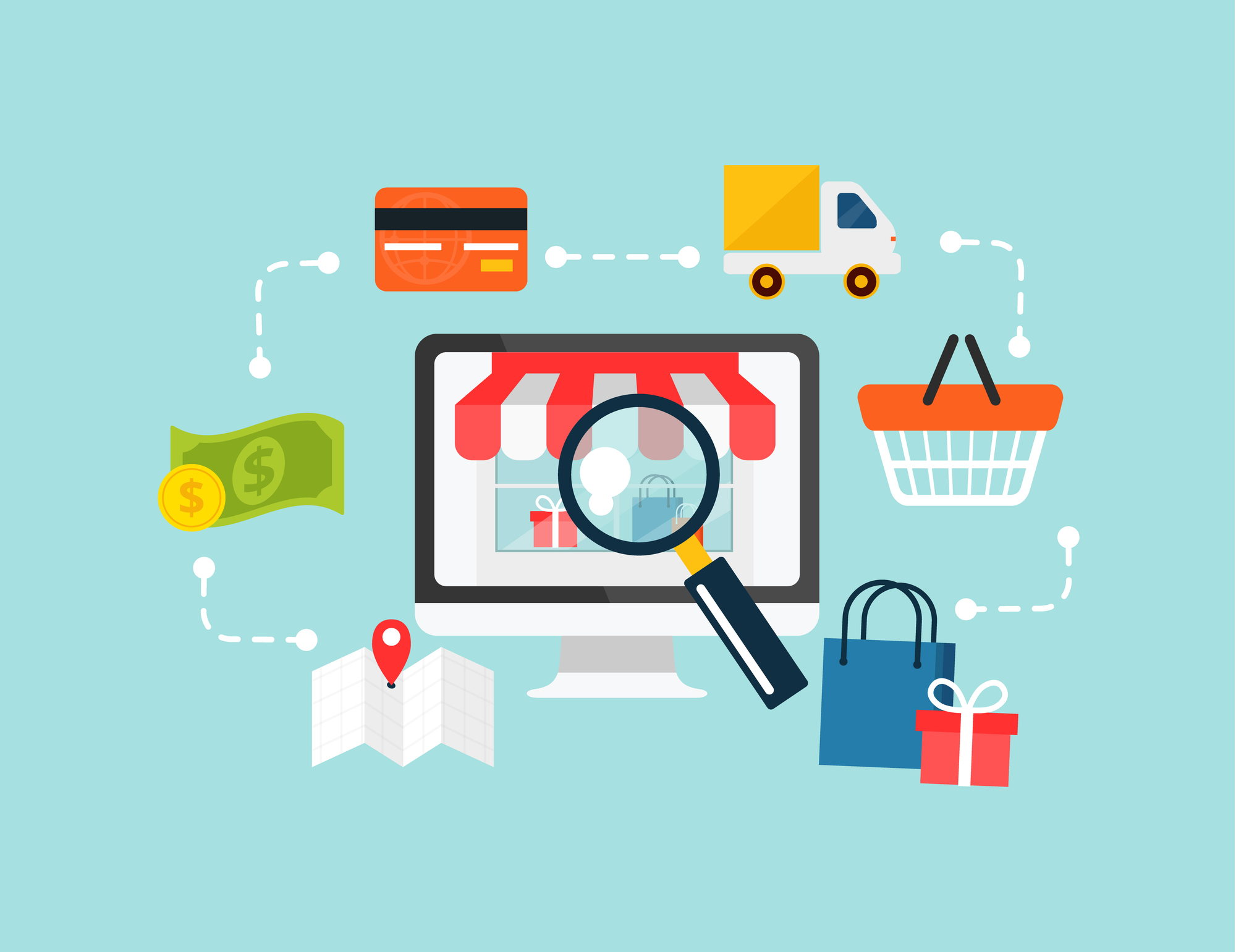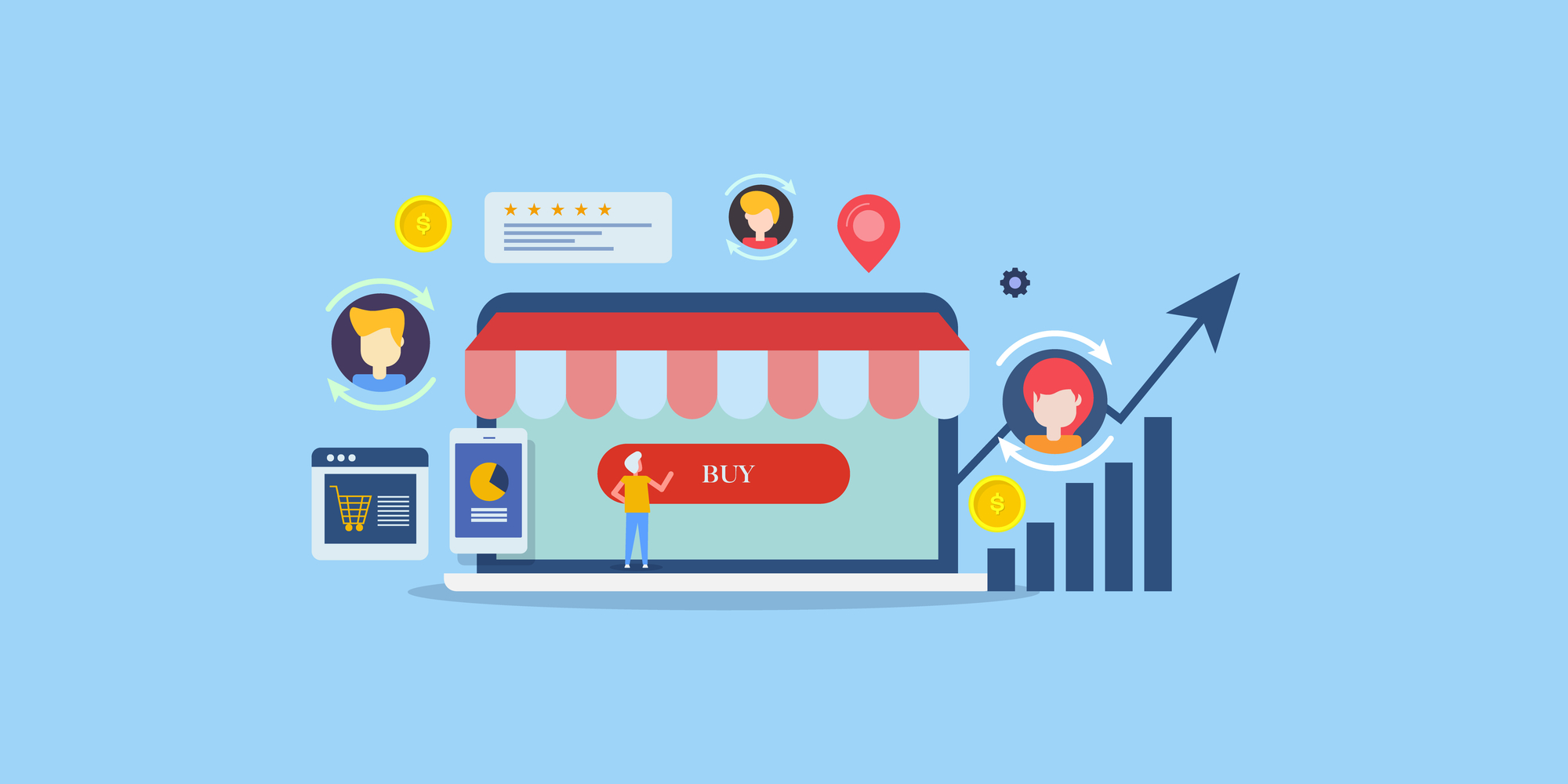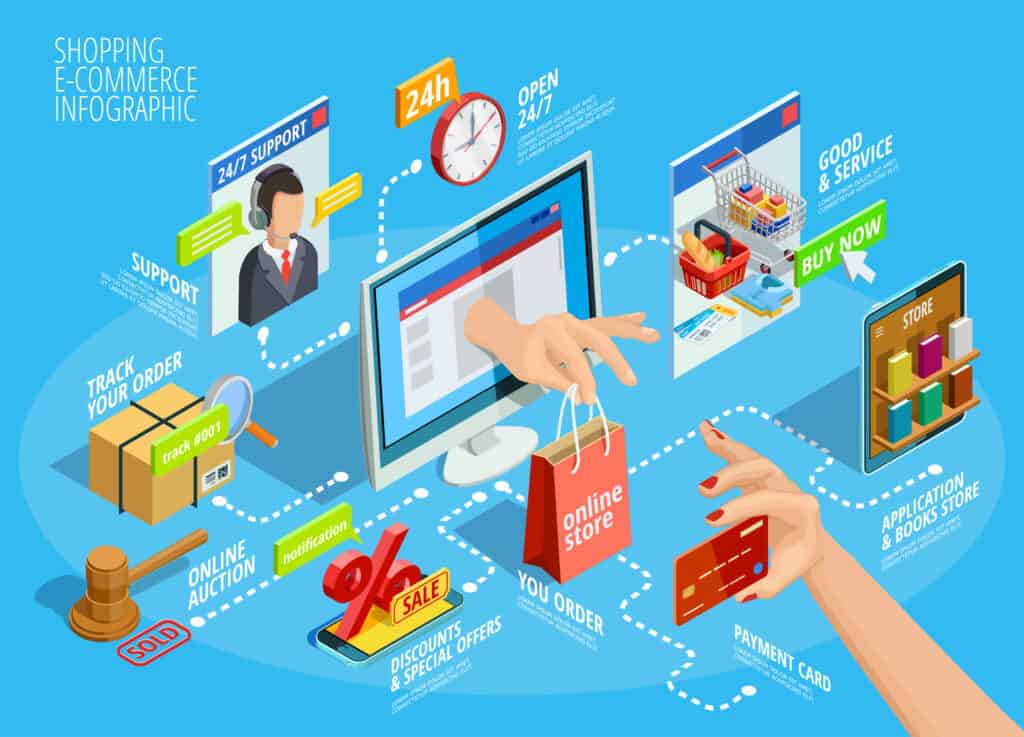
FREE Download For You
30 Best Tactics to
Maximize E-commerce Conversions
Have you ever stood outside a physical shop, marveling at its design and questioning how it was constructed? Well, building an ecommerce site isn’t much different. It requires careful planning, the right tools, and meticulous execution.
I remember my first attempt at creating an online shop – stumbling over product categories setup like tripping on uneven pavements; wrestling with payment gateways as if they were stubborn old locks. The world of website builders seemed more complex than city blueprints!
But then things clicked into place – inventory management started making sense like arranging stock shelves; customer experiences began to feel just as important as friendly salespeople.
The question is: Are you ready for this digital construction project? Ready to transform your business ideas into a successful online venture?
Hang tight if you’re intrigued. I’m just about to dive deeper into this.
Table Of Contents:
- Understanding the Basics of Building an Ecommerce Site
- Choosing Your Ecommerce Platform and Hosting Provider
- Designing Your Ecommerce Site with User-Friendly Website Builders
- Adding Products and Managing Inventory on Your Ecommerce Site
- Securing Payments and Building Customer Trust
- Leveraging SEO Tools for Better Visibility
- Expanding Your Ecommerce Reach through Multiple Channels
- Enhancing the Customer Experience on Your Ecommerce Site
- FAQs in Relation to Building an Ecommerce Site
- Conclusion
Understanding the Basics of Building an Ecommerce Site
Ecommerce is no longer a privilege, but rather a requirement for businesses. The rise in online shopping has been nothing short of phenomenal with e-commerce sales surging by as much as 40% in 2023, which was also the first pandemic year.
What is the significance of an ecommerce website and why should businesses utilize it?
An ecommerce website provides an opportunity to vend items or services directly from your webpage, making it handy for both the vendor and buyers. You don’t need a brick-and-mortar store to start selling; all you need is an effective e-commerce site.
The importance of having such a platform can’t be overstated. It’s like owning an always-open shop that serves customers around the globe right at their fingertips. But just building one isn’t enough – understanding how it works will give you more control over its success.
Key components for starting an online store
To get started, there are certain key elements every successful ecommerce site should have:
- Product Listings: This includes detailed descriptions, high-quality images, price point details, and product categories – everything potential buyers would want to know about what they’re considering buying.
- A Secure Payment Gateway: Trustworthy sites offer multiple payment options including credit card processing and PayPal among others ensuring customer data security during transactions.
- Fulfillment Solutions & Inventory Management Systems: This helps track stock levels efficiently while managing shipping rules effectively so orders get fulfilled promptly without hiccups.
In essence, learning how these parts work together forms part of mastering this digital business model. Once you grasp the fundamentals, it’s like understanding how to plant a seed that can grow into your very own MoneyTreeSeed. With proper nurturing and care, expect it to bear fruitful returns.
Building an ecommerce site is a must in today’s digital era, acting like your always-open global shop. Start by understanding its basics: create detailed product listings, secure payment gateways for trust-building and efficient inventory management systems for smooth order fulfillment. With proper care, this can become your very own profit-making machine.
Choosing Your Ecommerce Platform and Hosting Provider
Embarking on the ecommerce journey is an exciting endeavor. But, to start selling online effectively, you’ll need a solid foundation – that’s your ecommerce platform and hosting provider.
Selecting a reliable web hosting provider
Your choice of web host can make or break your site’s performance. It affects everything from speed to security, all crucial for providing positive customer experiences. A dependable host like Hostinger website hosting, ensures smooth operation so your business stays up and running around the clock.
When choosing a web host, consider factors such as uptime guarantee, support services availability, and data centers’ location for faster loading times globally. Also look into their experience with handling e-commerce sites specifically since these often require more resources than typical websites.
Comparing popular ecommerce platforms
The next big decision involves selecting an appropriate ecommerce platform. This will be the backbone of your online store; hence it needs to cater well not only towards building but also managing aspects like inventory management & payment gateway integration efficiently.
You want something intuitive yet powerful enough for when you scale up operations later down the line – think ‘built-in SEO tools’, multiple channels integrations etcetera.
Analyzing features of different platforms helps pick one tailored best towards individual needs & goals which in turn enhances overall shopping experience customers get while browsing through product categories or checking out using credit cards safely secured by SSL encryption provided via chosen hosts’ servers (yes another reason why picking right host matters.).
According to recent research findings (“Building an e-commerce website is easier and more intuitive than ever”– Source: Research 2), there are several contenders worth considering. For instance, Shopify excels in providing a fully customizable platform with strong marketing tools and support for multiple sales channels. WooCommerce offers great flexibility for those comfortable handling some technical aspects themselves.
Ultimately, the choice of ecommerce platform and hosting provider will significantly impact your online business’s success, so take the time to research your options thoroughly.
starting your ecommerce journey isn’t just about having a great idea. It’s also about setting up a solid foundation with the right platform and hosting provider. The host you choose can significantly affect your site’s performance, so it’s crucial to go for one that has experience handling ecommerce sites. This ensures optimal speed and security for your online store. Additionally, select an intuitive yet powerful ecommerce platform tailored to meet your specific needs – features like built-in SEO tools, channel integrations, inventory management and payment gateway integration are vital components of any successful ecommerce setup.
Designing Your Ecommerce Site with User-Friendly Website Builders
Making your ecommerce site stand out is no small feat. But don’t sweat it, user-friendly website builders like Wix, Web.com, and Squarespace can help you create a unique and visually appealing design without the need for extensive coding skills.
The Role of Website Builders in Creating a Successful Online Store
Website builders play an essential role in creating successful online businesses. They let you focus more on what matters most – selling products online. These tools offer easy-to-use interfaces that allow even beginners to build stunning websites.
You get access to pre-made website templates, which can be customized as per your brand’s aesthetic needs. The drag-and-drop feature helps make this customization process smoother than butter sliding off hot pancakes.
Picking the Right Website Builder for Your Needs
Selecting the right website builder hinges on multiple factors including ease-of-use, customizability, pricing structure, and customer support among others. If SEO is essential to your business strategy, then Wix may be the perfect option due to its in-built optimization features.
Squarespace stands tall if sophisticated designs tickle your fancy while Web.com could fit well into tight budgets offering free ecommerce options.
User-Friendly Does Not Mean Bland.
Website builders aren’t just about convenience – they also provide vast creative freedom to express your brand’s identity uniquely and memorably. You can add custom elements such as images or videos showcasing your products, use eye-catching fonts and colors, or even include customer reviews to enhance trust.
Remember that the design of your ecommerce site is not just about aesthetics. It’s also about creating a smooth shopping experience for your customers – think easy navigation through product categories, secure payment gateway integration, and an efficient checkout process.
Creating a standout ecommerce site doesn’t have to be hard. User-friendly website builders like Wix, Web.com, and Squarespace make the process easy with customizable templates and drag-and-drop features. But remember, picking the right builder depends on your specific needs – SEO tools, design options or budget-friendly plans. And don’t forget: A great site isn’t just about looks—it’s also about functionality and how well it serves its users.
Adding Products and Managing Inventory on Your Ecommerce Site
When it comes to your ecommerce website, two essential aspects are creating product postings and handling stock. Let’s break these down.
Setting up Product Listings and Descriptions
Your product listing is essentially a sales pitch for each item you sell. The more detailed and appealing your descriptions, the higher the chances that customers will be drawn to purchase.
You’ll need high-quality images, an engaging description, accurate specifications if applicable (like size or weight), and a competitive price point. Providing buyers with the necessary information about what they are purchasing is essential for successful online product sales.
Implementing Effective Inventory Management
The next step in adding products online involves keeping track of what you have in stock. This process is known as inventory management – but don’t let that term scare you off. It can actually be pretty straightforward with some planning ahead.
If we consider our ecommerce business like a physical store – imagine walking into one only to find half their shelves empty because they didn’t keep track of their stock levels correctly; not quite an ideal shopping experience.
Shopify offers a handy guide which makes this task easier by providing tips on how best manage shipping times so customer experiences remain positive even when demand spikes.
A Note About Shipping Rules
In addition to tracking inventory efficiently, it’s also essential that we implement effective shipping rules for our products online.
This includes deciding whether or not we want offer free shipping – while popular among consumers this could affect profit margins depending where goods are being shipped from/to.
We should think about introducing tiered rates based volume or weight instead.
Remember, your online store isn’t just about selling; it’s also about making sure the entire shopping experience is as smooth and enjoyable for your customers as possible. From browsing products to checkout – every step matters.
Setting up enticing product listings and effectively managing inventory are vital for your ecommerce site. Craft detailed, engaging descriptions with high-quality images to lure customers. Keep a keen eye on stock levels to avoid empty shelves – it’s all about enhancing the shopping experience. Don’t forget: shipping rules matter too.
Securing Payments and Building Customer Trust
Running a successful online business means more than just having an eye-catching site or quality products. You also need to secure customer trust by ensuring safe online transactions. The significance of strong safety protocols can’t be emphasized enough, especially when handling confidential customer information.
One key way to build this confidence is through the use of trusted payment solutions. These not only protect your customers but also provide them with familiar transaction methods they’re comfortable using, thereby boosting their confidence in your ecommerce site.
The stats don’t lie: according to Research 2, websites that prioritize secure payment processing are deemed more trustworthy by consumers.
Ensuring Secure Online Transactions
Incorporating SSL certificates into your website’s structure is one step towards creating a safer environment for shoppers. SSL certificates authenticate the identity of a website and encrypt data sent between server and browser, reducing the risk of sensitive information being accessed by hackers.
You might want to consider third-party services like PayPal or Stripe as additional layers of protection during transactions. They’re well-known brands recognized globally for their high-level security features which makes them favorites among customers shopping online who demand safety first when giving out financial information on any ecommerce platform.
Demonstrating Robust Security Measures Protecting Customer Data During Transactions
Your commitment to safeguarding user data shouldn’t stop at payments; make sure you’re transparent about how you handle other types of private customer info too. Include clear privacy policies detailing what kind of data you collect from visitors, why it’s needed, how long it’s kept, who has access – basically everything a concerned customer might want to know.
Trust seals can also be very effective in showing that you take security seriously. These badges from trusted third parties like Norton, McAfee, or TrustE signal to customers that your site is safe and their data secure.
Building a successful ecommerce site isn’t just about great products and design. It’s also about earning customer trust with secure transactions. Trusted payment solutions, SSL certificates, third-party services like PayPal or Stripe can boost security while clear privacy policies show transparency in data handling. Adding trust seals from trusted sources like Norton signals that your site is safe for shopping.
Leveraging SEO Tools for Better Visibility
SEO tools can be a game-changer when it comes to boosting your ecommerce site’s visibility on search engines. With the right set of tools, you’ll attract more organic traffic and rank higher in searches.
The Role of SEO in Ecommerce
The importance of SEO in ecommerce is hard to overstate. When people search for products online, they’re likely using terms related to what you sell. By optimizing your site with relevant keywords, meta descriptions, and alt tags – you make it easier for potential customers to find you.
Your chosen e-commerce platform may offer built-in SEO tools that help streamline this process but remember: not all platforms are created equal. Consider whether these built-in options meet your needs or if additional third-party apps might give better results.
Selecting Effective SEO Tools
An effective tool like the Yoast plugin makes managing these tasks simpler by analyzing keyword usage throughout your content and offering suggestions for improvement. This kind of proactive guidance helps ensure each page on your website aligns with best practices so users can easily find what they need.
With assistance from the latest technology, you don’t have to tackle this alone – there’s a world of support at your fingertips. So why not let them? After all, everyone could use some help now and then.
Pitfalls To Avoid
Beware though – merely having access to great tools isn’t enough. Using them correctly matters just as much as choosing which ones fit best with your business goals. For instance: stuffing too many keywords into one post will harm rather than help your SEO. Balance is key.
By leveraging the right tools and techniques, you can optimize your site for search engines, drive more organic traffic to your store, and make it easier for potential customers to find what they’re looking for.
Boost your ecommerce site’s visibility with SEO tools. They can help attract organic traffic and rank higher in searches. Remember, the right keywords, meta descriptions, and alt tags make it easier for customers to find you. Choose an effective tool like Yoast that guides keyword usage throughout your content but be careful not to overstuff keywords. Balance is key.
Expanding Your Ecommerce Reach through Multiple Channels
No longer can a business proprietor depend just on their physical shop or web-based store. To reach a wider audience and increase sales, it’s essential to start selling online across multiple channels.
Multichannel retailing, as this strategy is known, offers many benefits. It lets you connect with your customer base where they already spend time – be it marketplaces like Amazon and eBay, social media platforms like Facebook and Instagram, or even via email marketing campaigns.
Benefits of Multichannel Selling
Selling on multiple platforms can significantly boost your visibility. This strategy makes sure that potential customers encounter your products in more than one place which reinforces brand recognition.
You also get the chance to build a diversified revenue stream. So if one channel experiences downtime or lower sales for some reason (like algorithm changes), others can compensate for that drop-off.
Tips for Successful Multi-Channel Retailing
To ensure success in multichannel retailing, there are several points you need to consider:
- A consistent shopping experience: Make sure all your storefronts reflect the same branding elements – logo, color scheme etc., so shoppers recognize you immediately wherever they find you.
- Pricing Strategy: Pricing might vary based on different channels due to fee structures or competitive factors but aim for consistency as much as possible without hurting profits too much.
- Inventory Management: You’ll need an effective inventory management system capable of syncing stock levels across all channels.
Research shows that multichannel customers spend three times more than single-channel customers, which further underscores the importance of this strategy. By expanding your ecommerce reach through multiple channels, you’re not just increasing sales but also fostering customer loyalty and creating a successful online business.
Boost your ecommerce business by embracing multichannel selling. This approach lets you connect with customers across various platforms like Amazon, eBay, Facebook and email marketing campaigns. Not only does it enhance brand visibility but also builds diversified revenue streams and fosters customer loyalty. But remember to keep branding consistent, manage pricing strategically and maintain accurate inventory levels for success.
Enhancing the Customer Experience on Your Ecommerce Site
The success of your ecommerce business relies heavily on customer experiences. Giving customers a feeling of being appreciated and comprehended is just as essential to your ecommerce success as delivering top-notch items.
A Seamless Shopping Experience
Just as in a brick-and-mortar store, the ease with which customers can navigate your site plays a crucial role in their overall shopping experience. Make sure to categorize products clearly and use website templates that are both appealing and intuitive for users. Incorporating built-in SEO tools can help you better understand user behavior and adjust accordingly.
Personalized Recommendations
Your ecommerce site should do more than just sell; it should offer personalized recommendations based on browsing history or past purchases. By providing personalized recommendations, your ecommerce site can foster customer loyalty and ensure that customers return to your store in the future.
Social Media Integration
To make shopping even easier for customers, consider integrating social media into your e-commerce strategy. Platforms like Instagram provide options for direct product tagging, letting consumers buy right from their feed without needing to visit another page. (Instagram)
Fulfillment Solutions & Inventory Management
Maintaining real-time inventory updates reduces chances of stock-outs or overstocking – common issues that could frustrate shoppers if unaddressed. Source Also, efficient fulfillment solutions ensure timely delivery – essential for building trust among buyers.
Prompt Handling of Customer Reviews
Customer reviews serve two purposes: Customer reviews both provide potential buyers with assurance when making a decision, and give the business proprietor useful comments. Addressing customer reviews promptly and professionally is a simple yet effective way to improve overall customer satisfaction.
Secure Payment Gateway
Choosing a secure payment gateway is key. It doesn’t just smooth out transactions, but also builds trust with your customers. That’s why it’s crucial to pick a reliable solution that protects user data from possible breaches. And one such option? BigCommerce.
Building a successful ecommerce site is all about enhancing the customer experience. Make your website easy to navigate, offer personalized product recommendations and integrate social media for convenient shopping. Stay on top of inventory management and fulfill orders promptly while addressing customer reviews professionally. And don’t forget – secure payment gateways are vital in building trust.
FAQs in Relation to Building an Ecommerce Site
What is the average cost to build an ecommerce website?
The typical expense of crafting an ecommerce site ranges from $1,000 to $40,000. But this figure can shift based on your needs and features.
Are ecommerce sites profitable?
Ecommerce sites indeed can turn a profit. With robust strategies like competitive pricing, top-notch customer service and targeted marketing, they rake in big bucks.
How difficult is it to build an ecommerce website?
Building an e-commerce site isn’t rocket science but does demand some tech savvy. If you’re green at web development or design though, consider using easy-to-navigate builders or hiring pros.
What is the easiest way to build an ecommerce website?
Website builders such as Shopify or Wix are super simple for constructing stunning online stores without needing any coding skills.
Conclusion
Building an ecommerce site isn’t just about crafting a digital storefront. It’s about mastering the art of online selling.
From understanding your platform to creating compelling product listings, you’ve learned the nuts and bolts. Remember that securing payments and building customer trust are crucial.
Moving forward, leverage SEO tools for better visibility. Never underestimate the power of multiple channels in expanding your reach!
The heart of it all? Enhancing user experience – because nothing beats a satisfied customer returning for more purchases.
In essence, remember: every detail counts when starting an online business venture; from website design to inventory management – each aspect contributes towards establishing a successful ecommerce presence!
Ready to start growing your own money tree? Building an online business from home offers incredible freedom and income potential. To get started on the path to passive earnings, download our free guide outlining 20 profitable online business models.

FREE Download For You
30 Best Tactics to
Maximize E-commerce Conversions








